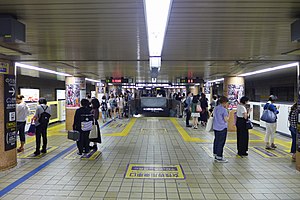Sakae Station (Nagoya)
M05 H10 Sakae Station 栄駅 | ||||||||||||||||
|---|---|---|---|---|---|---|---|---|---|---|---|---|---|---|---|---|
 Sakae Station Higashiyama Line Platform | ||||||||||||||||
| General information | ||||||||||||||||
| Location | Sakae 3-5-12, Naka, Nagoya, Aichi (名古屋市中区栄三丁目5-12) Japan | |||||||||||||||
| Operated by | ||||||||||||||||
| Line(s) | ||||||||||||||||
| Connections | ||||||||||||||||
| History | ||||||||||||||||
| Opened | 15 November 1957 | |||||||||||||||
| Previous names | Sakaemachi (until 1966 [1]) | |||||||||||||||
| Passengers | ||||||||||||||||
| 2008 | 26,376,104 [2] | |||||||||||||||
| Services | ||||||||||||||||
| ||||||||||||||||

Sakae Station (栄駅, Sakae-eki) is an underground metro station located in Naka-ku, Nagoya, Aichi Prefecture, Japan operated by the Nagoya Municipal Subway.[3] It is an interchange station between the Higashiyama Line and the Meijō Line and is located 9.0 rail kilometers from the terminus of the Higashiyama Line at Takabata Station and 3.0 rail kilometers from the terminus of the Meijō Line at Kanayama Station.
The station is connected underground with Hisaya-ōdōri Station (on the subway Meijō Line and Sakura-dōri Line) and with Sakaemachi Station (the terminus of the Meitetsu Seto Line).
History
Sakae Station was opened on 15 November 1957 as Sakaemachi Station (栄町駅, Sakaemachi-eki) as a terminal station on the No. 1 Line, later renamed the Higashiyama Line. The new subway system replaced the electric tram which had run above ground. The No. 2 Line (later named the Meijō Line) connected to the station on 15 October 1965. The station was renamed to its present name on 1 June 1966.[4]
Lines
 Nagoya Municipal Subway
Nagoya Municipal Subway
 Higashiyama Line (Station number: H10)
Higashiyama Line (Station number: H10) Meijō Line (Station number: M05)
Meijō Line (Station number: M05)
Layout
Sakae Station has one underground island platform for use by the Higashiyama Line and two underground opposed side platforms for use by the Meijō Line.
Platforms
| 1 | ■ Higashiyama Line | For Higashiyama Kōen and Fujigaoka |
| 2 | ■ Higashiyama Line | For Nagoya and Takabata |
| 3 | ■ Meijō Line | For Kanayama, Aratama-bashi, and Nagoyakō |
| 4 | ■ Meijō Line | For Shiyakusho and Ōzone |
The station is rather large and contains many businesses such as restaurants and shops. There are three sets of gates corresponding to three exits: the Central Exit, the East Exit, and the West Exit. Past the West Exit are exits 1, 2, 7, and 8. Exit 3 and Exit 6 are between the Central Exit and the West Exit. Past the East Exit are exits 4, 4A, and 5.[5]
References
- ^ 佐藤, 信之 (19 June 2004), "高度経済成長期の鉄道整備―昭和30~40年代", 地下鉄の歴史首都圏・中部・近畿圏 (in Japanese), グランプリ出版, p. 71, ISBN 4-87687-260-0
- ^ 平成21年版名古屋市統計年鑑 11.運輸・通信 [Nagoya Statistics for Year 21 of the Heisei Era, 11 Transportation and Communication] (in Japanese). Nagoya City. Retrieved 1 December 2010.
- ^ 栄 [Sakae] (in Japanese). Transportation Bureau City of Nagoya. Retrieved 19 November 2010.
- ^ 佐藤, 信之 (19 June 2004), 地下鉄の歴史首都圏・中部・近畿圏 (in Japanese), グランプリ出版, ISBN 4-87687-260-0
- ^ 駅構内図 [Diagram of Station Interior] (in Japanese). Transportation Bureau City of Nagoya. Retrieved 18 November 2010.